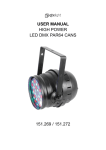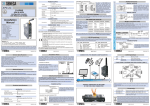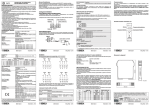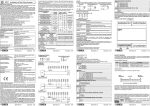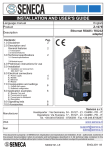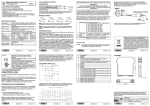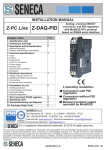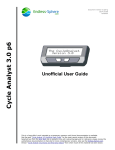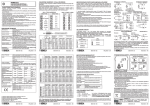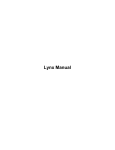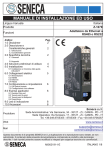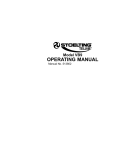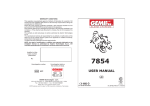Download User Manual
Transcript
EN Strain Gauge Converter General Description Module Z-SG is a strain gauge signal converter. Measurements taken using the 6-wires or 4-wires technique are available through Modbus-RTU serial protocol or the analog output. The module is also characterised by: Facilitated power supply and serial bus wiring by means of the bus housed in the DIN rail. Communication configurability by DIP-switch or software. RS485 serial communication with MODBUS RTU protocol, maximum 32 nodes. Protection against ESD discharge up to 4 kV. Input insulation: 1500 Vac compared to all the other circuits. Insulation between communication and power supply: 1500 Vac. Insulation between analog output and power supply: 1500 Vac. Analog output in voltage or current, with settable limits. Strain gauge calibration with standard weight. Strain gauge calibration not required if the sensitivity of the strain gauge is known. Configurable digital I/O. Rejection at 50 and 60Hz. Configurable Resolution. Sampling frequency settable from 12,53 Hz to 151,71 Hz. Stable weight indication via Modbus register/digital output. Remote writing of the tare in volatile and/or non-volatile memory by digital input/Modbus register/Modbus commands. Strain gauge directly powered by instrument. Ratiometric measurement. Sensitivity from "1 to "64 mV/V, settable by DIP-switch for integer values, via software for real/integer values. Alarm generated when programmable threshold is exceeded. Measurement stabilisation through the calculation of the moving average value of a programmable number of samplings. Complete configurability by Z-NET3 software. Technical Specifications Power supply : Consumption : 10..40 Vdc or 19..28 Vac (50..60 Hz) max 2.0 W Communication Ports : -RS485, 2400..115200 Baud. -RS232, 2400 Baud, Address: 01, Parity: NO, Data: 8 bits, Stop bits: 1. MODBUS-RTU Protocol : Analog Input Input Type : Full scale : Error : Insulation : 6-wires or 4-wires differential measurement input. " 5 mV .. " 320 mV Calibration : 0,01 % of the full scale value. Linearity : 0,01 % of the full scale value. Thermal Stability : 0,0025 % / °C of the full scale value. 1500 Vac respect to the remaining circuits. MI001204-E Strain gauge characteristics Power supply voltage : Minimum impedance : Sensitivity : Terminals : Analog Output Output Voltage : Output Current : Transmission error : Response time (10%..90%) : 5 Vdc 87 W equivalent (derived from several strain gauges connected in parallel). From "1 mV/ V to "64 mV/V. 4 or 6. 0..10 Vdc, 0..5 Vdc, minimum load resistance : 2 kW. 0..20 mA, 4..20 mA, maximum load resistance : 500 W. 0,1 % (max. range). 5 ms. Protection : Environmental conditions : Storage temperature : Signalling by LED : Connections : Box : Dimensions and weight : Reference standards : 24 bit. 25 ppm/K. settable from 12,53 Hz to 151,71 Hz. settable at either 50 Hz or 60 Hz. 1500 Vac between the measurement input and all the other circuits. 1500 Vac between power supply and communication. 1500 Vac between power supply and analog output. IP20 Temperature -10..+65 °C. Humidity 30..90 % non-condensing. Altitude: up to 2000 m a.s.l. -20..+85 °C Power supply, calibration, RS485 communication. -Removable 3-way screw terminals, 5,08 mm pitch. -Rear IDC10 connector for DIN rail. -3.5 mm stereophonic front jack for RS232 (COM) connection. -Lateral button for strain gauge calibration. PBT, black 100 x 112 x 17,5 mm, 140 g. EN61000-6-4/2002 (electromagnetic emission, industrial environment) EN61000-6-2/2005 (electromagnetic immunity, industrial environment) EN61010-1/2001 (safety). All circuits must be insulated from the other circuits under dangerous voltage with double insulation. The power supply transformer must comply with EN60742: “Insulated transformers and safety transformers”. MI001204-E ENGLISH - 2/16 Calibration Button ERR PWR SW1 SW2 RX 2 3 10 ÷ 40 VDC 19 ÷ 28 VAC TX COM S Z-SG SW3 7 8 9 10 11 12 To use the lateral button for calibration, move to OFF position the DIP-switch 1 of SW2. DESCRIPTION OF OPERATION MI001204-E 2.0 W Power Supply AC- RS485 A RS485 B IDC10 There is no insulation between RS485 and the analog output. RS232 SERIAL PORT Connection cable DB9 with a 3.5 mm stereo Jack, can be assembled as indicated in the following figure, or can be bought as an accessory. DB9-F 9 5 6 1 GND Tx 3.5 mm Stereo Jack Rx GND Tx ANALOGUE INPUT Rx The figure below shows the connections to be made for connection to a strain gauge. The terminals have the following meaning: 6 wires measurement + Sense - Signal 12 - Sense 11 10 + Excitation 7 8 9 + Signal ENGLISH - 3/16 - Signal 12 Stable Weight Function ANALOG OUTPUT The module provides an analog output in voltage (0..10 VDC, 0..5 VDC) or current (0..20 mA, 4..20 mA). We recommend using shielded cables for the electric connections above. Analog Output The analog output permits the retransmission of the net weight as follows: -If the Net Weight in units of weight # MINOUT, the output relays 0%. - If the Net Weight in units of weight $ MAXOUT, the output relays 100%. -At intermediate values, the progression is linear. Where MINOUT and MAXOUT in Mode 1 and 2 may be set via MODBUS (The default values are respectively: 0,00 and 10000,00). Rejection at 50 and 60 Hz Rejection to interference at both 60 and 50 Hz can be enabled at the same time. See Appendix A for details on setting and optimisation. + 5 Digital input/output The instrument offers the possibility to select either a digital input or a digital output. This selection (input or output) is made only by DIP-switch. Digital Input: allows to memorize the tare during all the calibration phases and may be used as an alternative to the lateral button. On the normal functioning it may be used to acquire the temporary tare, which will be lost at the turn off of the module; at the next start up the tare value, acquired on calibration, will be loaded. Digital Output: the output can be configured via Modbus for three different operating modes and switches to ON or OFF status (always according to Modbus setting) whenever: 1)The Gross Weight exceeds the Full Scale of the strain gauge (Default Setting). 2)The Weight is stable and the Net Weight exceeds the threshold set. 3)The Weight is stable. V Current Output 4 + A 5 There is no insulation between RS485 and the analog output. DIGITAL INPUT/OUTPUT 1 + + V 24 Vdc PROGRAMMING 24 Vdc 6 1 PWR LED (GREEN) Meaning Power supply is present. ERR LED (YELLOW) Meaning Calculation of Measurement Moving Average Steady/Flashing Signallings relative to the calibration phases. For further informations see the Calibration Addendum, containing the calibration procedures. Installation rules RX LED (RED) Meaning Data are being received through the RS485 communication port. The moving average of a settable number of samples (NR_SAMPLINGS: 1 ..100) can be calculated. In this way, the Net Weight displayed is the calculated moving average value. For Mode 1 and 2, NR_SAMPLINGS may be set via MODBUS (default: 100). The module is designed to be installed in vertical position on a DIN 46277 rail. In order to ensure optimum performance and the longest working life, the module(s) must be supplied adequate ventilation and no raceways or other objects that obstruct the ventilation slots. Never install modules above sources of heat; we recommend installation in the lower part of the control panel. Steady TX LED (RED) Steady STRAIN GAUGE SENSITIVITY SW2 6 7 8 ± 1 mV/V ± 2 mV/V ± 4 mV/V ± 8 mV/V ± 16 mV/V ± 32 mV/V ± 64 mV/V Sensitivity from MODBUS register SENSE_RATIO (40044). Real values (not only integer) may be set too. Load INDICATIONS BY LED ON THE FRONTAL PANEL Steady The release of Z-NET3 software to be used for product’s programming/configuration, must be the 1.0.2883 or later. This software may be downloaded from the web site www.seneca.it. During initial programming, the EEPROM (SW3 ..8 in OFF position) default setting values originally programmed as follows can be used: Address = 1, SPEED = 38400 baud, PARITY = none, BIT NUMBER = 8, STOP BIT = 1. The module can also be programmed through the front connector (COM) while paying attention to set the following connection parameters: Address = 1, Speed = 2400 Baud, PARITY = none, STOP BIT = 1. The Com communication port behaves in the same way as the RS485 bus port except for the communication parameters described above. It also has priority over the RS485 serial port and closes after 10 seconds of inactivity. Meaning Data are being transmitted through the RS485 communication port. Electric connections RS485 SERIAL PORT AND POWER SUPPLY SERIAL INTERFACE The electric connections for power supply can be made by using either the terminals or the bus for the Seneca DIN rail. The RS485 bus connections are available only by using the bus for the DIN rail. For detailed information on RS485 serial interface, consult the documentation provided by the website www.seneca.it, in the section Prodotti/Serie Z-PC/MODBUS TUTORIAL. MI001204-E MI001204-E ENGLISH - 4/16 ENGLISH - 7/16 Digital Output Digital Input V MI001204-E RS485 TERMINATOR SW3 1 2 x Terminator OFF, the SW3-2 is not used. x Terminator ON, the SW3-2 is not used. The module can be set to provide either a digital input or digital output. The connections in the two cases are as follows: 6 UTILIZE / CALIBRATION MODE (**) SW2 4 5 Modes 2 and 4 are selected. Modes 1 and 3 are selected. The tare value acquired by the lateral button or digital input is saved on non-volatile memory (for Modes 2 and 4). Manual calibration of the strain gauge (for Modes 1 and 3). ENGLISH - 5/16 The Stable Weight function informs the user of the precise moment in which weight has stabilised. This information is available via Modbus register (see the Modbus Registers section, Register 40066: STATUS) and can also be signalled by digital output (after previous selection and programming by Modbus). This function is characterised by the two parameters: DWeight and DTime. The weight is considered stable whenever the net weight in the DTime has changed by a quantity lower than DWeight. 4 0..10 V 0..5 V 0..20 mA 4..20 mA (**) For further informations consult the Calibration Addendum, containing the calibration procedures. - Excitation MI001204-E Voltage Output Communication Parameters from EEPROM (*) Fixed Address: 01 Fixed Address: 02 Fixed Address: 03 Fixed Address: 04 X X X X X X Fixed Address, as from binary representation. Fixed Address: 63 (*) The default configuration is the following: Address 1, 38400, no parity, 1 stop bit. 11 10 - Excitation ADDRESS SW1 3 4 5 6 7 8 OUTPUT SW2 2 3 4 wires measurement + Excitation 7 8 DIP-SWITCH SETTING The settings of the DIP-switches define the module's communication parameters (address and speed) and other parameters we are going to explain. In order for the setting modifications made to be confirmed valid, the module must be switched off and on again. In all the following tables, the indication corresponds to a DIP-switch set in ON; no indication is provided when the DIP-switch is set in OFF. COMMUNICATION SPEED (BAUDRATE) SW1 1 2 9600 Baud 19200 Baud 38400 Baud 57600 Baud DIGITAL I/O SELECTION - ENABLING LATERAL BUTTON OF CALIBRATION SW2 1 Digital Input. Besides it enables the lateral button of calibration (**). Digital Output 7: Strain gauge positive power supply 8: Strain gauge positive power supply reading 9: Strain gauge positive reading 10: Strain gauge negative power supply 11: Strain gauge negative power supply reading 12: Strain gauge negative reading The use of shield cables is necessary for the electronic connections. 9 + Signal The strain gauge's measured value is translated into an analog output signal (current or voltage). The measurement of the input is available through Modbus RTU protocol upon query by RS485 bus and/or RS232 jack. Serial communication parameter settings can be made either by Modbus RTU or DIPswitch, whereas the settings selectable via SW2 cannot be configured via Modbus (except the sensitivity). The instrument's various functions are described below. Power Supply AC+ RS485 GND 1 DIP-switch Position Lateral button for calibration 1 2 3 4 5 6 ENGLISH - 1/16 Digital Input or Output (as alternative) Max Voltage : 30 V. Optoisolated digital Input : Max Current : 50 mA, Max Voltage : 30 V. Optoisolated digital Output : Other Features ADC : Thermal drift : Sampling frequency : Interference rejection : Insulation voltage : The calibration procedures are illustrated in detail on the appropriate attached addendum. Anyway they are briefly listed below. Calibration Mode 1 The user has at his disposal a PC with Z-NET3 software (release 1.02883 or later, to download from www.seneca.it web site) and a weight of known value. It is not necessary that the known weight is equal to the full scale of the strain gauge or to the full scale of the measurement. Calibration Mode 2 The user has at his disposal a PC with Z-NET3 software and a strain gauge with declared sensitivity. Calibration Mode 3 The user does not have at his disposal a PC but has a weight of known value equal to the full scale of measurement. Calibration Mode 4 The user does not have at his disposal a PC and a weight of known value but has only a strain gauge with declared sensitivity. Frontal Panel and Leds Bus connector for DIN rail Power Supply from terminals MODULE Z-SG CALIBRATION Z-SG ENGLISH - 6/16 R THE INTERNATIONAL CERTIFICATION NETWORK ISO9001-2000 SENECA s.r.l. Via Germania, 34 - 35127 - Z.I. CAMIN - PADOVA - ITALY Tel. +39.049.8705355 - 8705359 - Fax +39.049.8706287 e-mail: [email protected] - www.seneca.it MI001204-E ENGLISH - 8/16 MODBUS REGISTERS Z-SG has MODBUS 16 bits (words) registers, accessible by RS485 or RS232 serial communication. In the next paragraphs, we shall describe the supported MODBUS commands, and the functions of the registers. Supported MODBUS Commands Code 03 (*) 04 (*) 06 16 Function Read Holding Registers Read Input Registers Write Single Register Write Multiple Registers Description Reading of word registers up to 16 at a time. Reading of word registers up to 16 at a time. Writing of a word register. Writing of word registers up to 16 at a time. (*) The two functions have the same effect. KNOWN WEIGHT_FL_L MAXOUT_FL_H Bit [15:8] HOLDING REGISTER The 16-bit Holding Registers have the following structure: Most Least Bit Index Significant bit Significant bit MAXOUT_FL_L 15 14 13 12 11 10 9 8 7 6 5 4 3 2 1 0 Word (16 bits): MODBUS Register The Bit notation [x:y] shown in the table indicates all the bits from x to y. For example, Bit [2:1] indicates bit 2 and bit 1, and illustrates the meaning of the various linked combinations of the values of the two bits. Remember that the MODBUS 3, 4, 6 and 16 single and multiple reading and writing functions can be executed on the following registers. The following indication (only readable or also writable) is provided for every register: R: Readable W: Writeable REGISTER MACHINE ID Description ADD. R/W Bit [15:8]: contain the module's ID: 23 40001 R (hexadecimal: 0x17). Bit [7:0]: contain the firmware's revision. FW_CODE Register that contains the firmware's internal 40002 code. R HW_REL Register that contains the instrument's 40003 hardware version. R ADDR Register for the setting of the module's 40004 R/W address and parity control. Set the module's address. Permissible values from 0x00 to OxFF (decimal values in the range of 0-255 ). Default address: 1. Bit [15:8] MI001204-E Set the type of parity control: 00000000 : No parity ( NONE ) (Default) 00000001 : Even parity ( EVEN ) 00000010 : Odd parity ( ODD ) Register for the setting of the Baudrate and 40005 R/W BAUDR the response delay time in characters. Set the serial communication speed value Bit [15:8] (Baudrate) : 00000000 (0x00) : 4800 Baud. 00000001 (0x01) : 9600 Baud. 00000010 (0x02) : 19200 Baud. 00000011 (0x03) : 38400 Baud (Default). 00000100 (0x04) : 57600 Baud. 00000101 (0x05) : 115200 Baud . 00000110 (0x06) : Not permitted. 00000111 (0x07) : 2400 Baud. Bit [7:0] Set the response delay time in characters that represents the number of pauses of 6 characters each to be entered between the end of the Rx message and the start of the Tx message. Default value: 0. SENSE RATIO _FL_H Sensitivity of the strain gauge in mV/V 40044 R/W (floating point format, most significant word). If the DIP-switches: SW2-7/8/9 are all in ON Bit [15:8] position, the sensitivity of the strain gauge in mV/V is set by this register (floating point format, most significant word). SENSE RATIO _FL_L Sensitivity of the strain gauge in mV/V 40045 R/W (floating point format, least significant word). Bit [15:8] FULL SCALE _FL_L KNOWN WEIGHT_FL_H Bit [15:8] Full scale of the strain gauge in technical 40046 R/W units (floating point format, most significant word). If the full scale of the strain gauge is declared (Mode 2: with both SW2-4/5 in OFF position), sets the full scale of the strain gauge in technical units of weight (kg, pounds, etc). Floating point Format, most significant word. Default: 10000,00. Full scale of the strain gauge in technical 40047 R/W units (floating point format, least significant word). Known weight of the strain gauge in technical 40048 R/W units (floating point format, most significant word). If the full scale of the strain gauge is not declared MI001204-E Bit [15:8] MINOUT_FL_L THRES_FLOAT_H Bit [15:0] THRES_FLOAT_L ENGLISH - 9/16 Bit [7:0] FULL SCALE _FL_H MINOUT_FL_H ENGLISH - 10/16 (Mode 1: SW2-4=OFF and SW2-5=ON), it sets the known weight of the strain gauge in technical units of weight (kg, pounds, etc). Floating point format, most significant word. Default: 10000,00 Known weight of the strain gauge in technical 40049 R/W units of weight (floating point format, least significant word). Value of the net weight in technical units of 40050 R/W weight which corresponds to the maximum value of the analog output (floating point format, most significant word). Value of the net weight in technical units of weight which corresponds to the maximum value of the analog output (100%). The value is in floating point format (most significant word) and so it has to be referred to the net weight in floating point format. Default: 10000,00. Value of the net weight in technical units of 40051 R/W weight which corresponds to the maximum value of the analog output (floating point format, least significant word). Value of the net weight in technical units of 40052 R/W weight which corresponds to the minimum value of the analog output (floating point format, most significant word). Value of the net weight in technical units which corresponds to the minimum value of the analog output (0%). The value is in floating point format (most significant word) and so referred to the net weight in floating point format. Default: 0,00. Value of the net weight in technical units of 40053 R/W weight which corresponds to the minimum value of the analog output (floating point format, least significant word). Threshold in unit of weight (floating point 40054 R/W format, most significant word). If the net weight (WEIGHT_FLOAT: 40064-65) exceeds the threshold value set and the weight is stable, the digital output (whenever set in the second operating mode) is closed or opened. Default: 0,00. Threshold in unit of weight (floating point 40055 R/W format, least significant word). MI001204-E DWEIGHT_FLOAT_H Bit [15:0] DWEIGHT_FLOAT_L DTIME Bit [15:0] RESOLUTION/ DIGITAL_OUT_TYPE Bit 15 Bit [14:8] Bit 7 Bit [6:0] Bit [15:0] WEIGHT_SHORT WEIGHT_FLOAT_H WEIGHT_FLOAT_L ENGLISH - 11/16 Weight variation in technical units accepted 40056 R/W for stable weight (floating point format, most significant word). With the Register 40058 (DTime), it permits to establish when the weight is stable. This represents the variation in units of weight accepted for stable weight. Weight is considered stable whenever the net weight (WEIGHT_FLOAT: 40064-65) in the DTime has changed by a quantity < than DWeight. Default: 1. Weight variation in technical units accepted 40057 R/W for stable weight (floating point format, least significant word). Time in units of 100 ms used to establish 40058 R/W whether or not the weight is stable. With the registers 40056-57 (DWeight) establishes whether or not the weight is stable, and is expressed in units of 100 ms. Weight is considered stable whenever the net weight (WEIGHT_FLOAT: 40064-65) in the DTime has changed by a quantity < than DWeight. Default Value: 1 (100 ms). Sets the resolution and the shifting of the 40059 R/W digital output (if selected by DIP-switch). 0: Resolution set by bit [14:8] 1: 24 bit Resolution If Bit 15 = 0 it sets the resolution value multiplied by 1000. Default: 30000 monopolar points. Defines the shifting of the output upon the appearance of the condition set by the Bit[6:0]: 0 : The output is normally opened and closes whenever the condition selected arises (default). 1 : The output is normally closed and opens whenever the condition selected arises. Defines the operation of the digital output and switches to ON or OFF (according to the status of Bit 7) when any of the following conditions arise: 0: The Gross Weight exceeds the Full Scale (Default setting). 1: The Weight is stable and the Net Weight exceeds the threshold set. 2: The Weight is stable. Net Weight=WEIGHT_FLOAT (40064-65). MI001204-E Configuration register for setting of rejection 40060 R/W and sampling frequency. The value of this register sets the sampling frequency and the characteristics interference rejection. Appendix A provides the values of these parameters according to the value set in this r e g i s t e r. D e f a u l t v a l u e : 8 2 ( 0 x 0 0 5 2 ) , corresponding to the Sampling Frequency: 49,95 Hz, Rejection at 50 Hz and 60 Hz: Enabled. NRSAMPLINGS_TARE Sets the number of samplings of the ADC 40061 R/W upon which the moving average will be calculated and indicates the tare value used. Bit [15:9] Not used Bit 8 Used Tare value (only for Modes 2 and 4): 0: the value of the tare had not never been written on the memory: at the start up the factory value will be loaded. 1: the value of the tare had been written at least once on the memory: at the start the last set value will be loaded. Bit [7:0] The number of samplings upon which the moving average must be calculated. The WEIGHT_FLOAT Register provides the mean value calculated. Permissible values: 1..100. Default: 100. 40062 R Filtered ADC value. ADC_VAL CONFIG FREQ_REJ ENGLISH - 12/16 Net weight value in ±30000 scale. 40063 Net weight value in ± 30000 scale. Equal to 0: if the WEIGHT_FLOAT (40064-65) is equal to MINOUT_FL (40052-53, value of the weight corresponding to the minimum value of the analog output). Equal to 30000: if the WEIGHT_FLOAT is equal to MAXOUT_FL (40050-51, value of the weight corrisponding to the maximum value of the analog output). Values<0 if WEIGHT_FLOAT<MINOUT_FL. Limited: -31000..+31000. Register containing the net weight value in 40064 technical units of weight (floating point format, most significant word). Register containing the net weight value in 40065 technical units of weight (floating point format, least significant word). MI001204-E R Remote Memorizing of the Tare The memorizing of the tare may be perfomed in the following ways: Memorizing Memorizing Action in Nonin Volatile Volatile Memory Memory Digital Input with ON Digital Input with ON Digital Input with ON Bit in reg. STATUS or with Command 49594 Bit in reg. STATUS or with Command 49594 ON ON Command: 49914 with ON Command: 49914 with ON 4 5 4 5 4 5 4 5 4 5 4 5 4 5 Notes Only for Modes 2 or 4. Once the tare has been saved, restart the module in these modes. - APPENDIX A Configuration of Sampling Frequency, Rejection. The table below provides the values that can be set in the Modbus register CONFIG FREQ_REJ (40060) together with the corresponding sampling frequency values. It is also indicating whether rejections are enabled at 50 or 60 Hz. R R Value of Register: CONFIG FREQ_REJ (40060) 27 55 82 109 155 183 210 237 ENGLISH - 13/16 Sampling Freq. (Hz) Rejection: Rejection: 50 Hz 60 Hz 151,71 74,46 49,95 37,59 50,57 24,82 16,65 12,53 MI001204-E NO NO YES NO NO YES YES NO NO NO YES YES NO NO YES YES ENGLISH - 15/16 STATUS Bit [15:5] Bit 4 Status Register 40066 R/W Not used. Stable weight 1: signals that the weight is stable. Bit 3 Memorizing of the tare on volatile memory: 1 : a memorizing of the tare is required (the value is valid up to the next start up of the module). Gross Weight # Memorized Tare: Bit 2 1: signals that the gross weight is # Tare value saved in memory. Gross Weight $Max Full Scale of the strain gauge: Bit 1 1 : signals that the gross weight is $ Maximum allowed Full Scale. Alarm Status: Bit 0 1: It signals that the net weight value has exceeded the threshold and that the weight is stable. STATUS_DIP-SWITCH Status of the Dip-switches. 40067 R Bit 15 Indicates the status of DIP1-SW1. Bit 14 Indicates the status of DIP2-SW1. Bit 13 Indicates the status of DIP3-SW1. Bit 12 Indicates the status of DIP4-SW1. Bit 11 Indicates the status of DIP5-SW1. Bit 10 Indicates the status of DIP6-SW1. Bit 9 Indicates the status of DIP7-SW1. Bit 8 Indicates the status of DIP8-SW1. Bit 7 Indicates the status of DIP1-SW2. Bit 6 Indicates the status of DIP2-SW2. Bit 5 Indicates the status of DIP3-SW2. Bit 4 Indicates the status of DIP4-SW2. Bit 3 Indicates the status of DIP5-SW2. Bit 2 Indicates the status of DIP6-SW2. Bit 1 Indicates the status of DIP7-SW2. Bit 0 Indicates the status of DIP8-SW2. 40068 R/W Commands Register. COMMAND Bit [15:0] By inserting the next codes the following actions are performed: 43948 (0xABAC): Module reset. 49594 (0xC1BA): Save the tare in volatile memory. 49914 (0xC2FA): Save the tare in volatile and non- volatile memory. 50700 (0xC60C): Save the known weight in nonvolatile memory. MI001204-E ENGLISH - 14/16 Disposal of Electrical & Electronic Equipment (Applicable throughout the European Union and other European countries with separate collection programs) This symbol, found on your product or on its packaging, indicates that this product should not be treated as household waste when you wish to dispose of it. Instead, it should be handed over to an applicable collection point for the recycling of electrical and electronic equipment. By ensuring this product is disposed of correctly, you will help prevent potential negative consequences to the environment and human health, which could otherwise be caused by inappropriate disposal of this product. The recycling of materials will help to conserve natural resources. For more detailed information about the recycling of this product, please contact your local city office, waste disposal service or thè retail store where you purchased this product. This document is property of SENECA srl. Duplication and reprodution are forbidden, if not authorized. Contents of the present documentation refers to products and technologies described in it.All technical data contained in the document may be modified without prior notice Content of this documentation is subject to periodical revision. R THE INTERNATIONAL CERTIFICATION NETWORK ISO9001-2000 SENECA s.r.l. Via Germania, 34 - 35127 - Z.I. CAMIN - PADOVA - ITALY Tel. +39.049.8705355 - 8705359 - Fax +39.049.8706287 e-mail: [email protected] - www.seneca.it MI001204-E ENGLISH - 16/16


